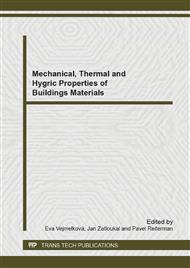p.1
p.6
p.11
p.16
p.22
p.27
p.32
p.38
Moisture Transport Properties of Hydrophilic Mineral Wool
Abstract:
Mineral wool materials are widely used for thermal insulation of buildings due to their low thermal conductivity and high fire resistivity. On this account, they are popular materials for passive fire protection of buildings. Thermal insulation boards are usually provided with hydrophobic admixtures that ensure their functional properties even in the contact with moisture. In this paper we focused on investigation of hygric transport properties of hydrophilic mineral wool materials that could find application in interior thermal insulation systems as well as in desalination and drying of salt laden materials and building structures. The obtained results give evidence of the effect of fiber orientation on studied material properties and reveal that fiber orientation perpendicular to board surface is a perspective way of materials development.
Info:
Periodical:
Pages:
6-10
Citation:
Online since:
July 2014
Authors:
Price:
Сopyright:
© 2014 Trans Tech Publications Ltd. All Rights Reserved
Share:
Citation:


